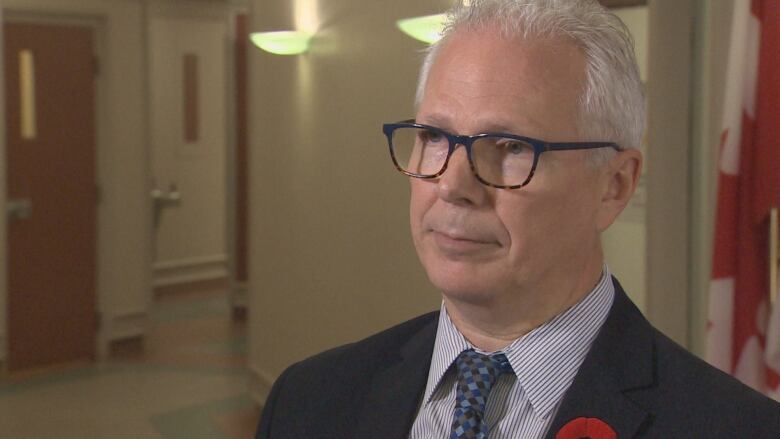WorkSafeNB claims process preventing injured workers from returning sooner: AG report
WorkSafeNB needs focus on return-to-work outcomes, says report

WorkSafeNB says it accepts all of the auditor general's recommendations to improve deficiencies in the Crown corporation's handling of injured worker claims.
Kim MacPherson's report, which focused on claim management, found the process lacks a return-to-work focus, creates unnecessary delays, needs new claim management software and suffers from a general lack of communication.
Those deficiencies are preventing injured workers from returning to work sooner, she said.
"What we found is that generally the policies and the practices within WorkSafe are in line with other workers' compensation organizations across the country," MacPherson told reporters Wednesday.
"But when it comes to managing injured worker claims, there is a lot WorkSafe can do to reduce the time the injured worker is off by ingraining in their processes this focus on return to work."
That focus will reduce the duration and cost of the claim, she said.
WorkSafeNB said in a statement Wednesday the recommendations are an "opportunity to improve the medical treatment and return to work outcomes."

"[The recommendations] fully align to the objectives of our business transformation that is currently underway to significantly improve process efficiencies and outcomes for injured workers and employers," the statement said.
Doug Jones, president and CEO of WorkSafeNB, thanked MacPherson in a tweet.
Id like to thank Kim MacPherson, Auditor General, for her work on both phases of WorkSafeNBs audit. The recommendations will help us be a better organization and provide the highest level of service to our clients. #nbpoli
—@DougJones_NB"The recommendations will help us be a better organization and provide the highest level of service to our clients," he said.
Daniel Theriault, chair of the Workers' Compensation Appeals Tribunal, agreed with MacPherson's statement that the recommendations will be "mutually beneficial" to injured workers and employers.
"Anytime you can speed up the process and try to get the injured worker back to work, it's good for the injured worker and it's certainly good for the employer," he said.
29 recommendations
The report outlined 29 recommendations to be implemented before the end of 2021. They include:
- Automate the claim management software to improve efficiency and tracking;
- Develop detailed case plans with return-to-work goals, proposed treatments, forecast recovery date;
- Have case managers speak with injured workers about their abilities and limitations in forming the return-to-work plan;
- Follow up with injured workers and health care providers about treatment and closely monitor claims;
- Train case managers to better understand specific types of injuries and refer those claims to them;
- Develop key performance indicators and targets for internal processes;
- Promote early referrals to the Workers' Rehabilitation Centre.
MacPherson said the Workers' Rehabilitation Centre in Grand Bay-Westfield is often used as a "last resort" in complex cases.
"[WorkSafeNB] should consider these complex cases going to the rehab centre earlier in their treatment plan, rather than waiting until after they've exhausted every other opportunity," she said.
Skyrocketing claims
The report, released Wednesday, is the second of two from the auditor general's office on WorkSafeNB in the past seven months. In June, MacPherson found the corporation is plagued by poor governance and lack of oversight.
The cost of claims has also skyrocketed in recent years. The figure soared more than $300 million since 2013, reaching $486 million in 2017, the report stated.
And New Brunswick employers are feeling the brunt in the premiums they pay. Starting Jan.1, they are paying $2.65 for every $100of payroll almost double what they were paying two years earlier.

Most, including MacPherson in her report, point to the Workers' Compensation Appeals Tribunal, a quasi-judicial tribunal that's independent of WorkSafeNB, as the reason for theballooning costs.
Critics say the scope of its powers were too broad and that led to a high number of decisions being overturned.
MacPherson's report recommended amending legislation so that appeals go the issues resolution office beforethe tribunal.
Theriault, the tribunal chair, said it makes sense to consider the appeal internally before sending it to the independent body.
New legislation
In an effort to tackle rising premiums, the Higgs government passed legislation in December ending the tribunal's power to overrule WorkSafeNB policies when hearing claim cases.
Theriault, the tribunal chair, said he was consulted on the auditor general's first WorkSafeNB report, but not the second one. If he had been, Theriault said he would have clarified some of MacPherson's findings.

"I'm assuming she received her information mainly from WorkSafe ... and didn't challenge it," he said.
For instance, the report stated WorkSafeNB, due to WCAT decisions, continues to pay benefits for non-compensable injuries something that's inconsistent with the rest of Canada.
Theriault said the tribunal is only following case law that dates back two decades.
The new legislation has changed that, he said, and WorkSafeNB will be introducing new policies.












_(720p).jpg)


 OFFICIAL HD MUSIC VIDEO.jpg)
.jpg)



























































































